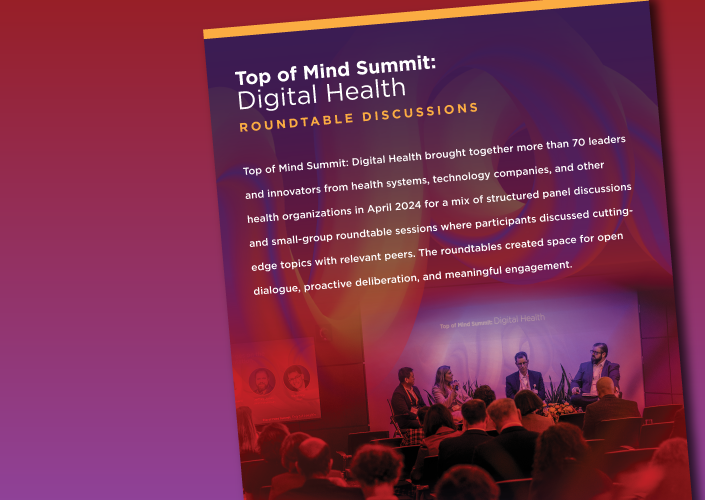Experts say patient-provider connection can be maintained, ‘web-side’ manner can be taught
Telehealth has many advantages for patients and health systems. It’s convenient for patients and efficient for providers. It can lower costs and open up access to care for people who may be far away from specialists.
But is the personal connection between patient and physician lost when an in-person visit is replaced with a telemedicine visit?
The question of maintaining empathy and connection was one of many telehealth topics discussed and debated by a panel of digital health experts during a live breakout session at the Top of Mind Online virtual summit. The panel also discussed reimbursement, volumes and utilization, and the regulatory environment.
Organized by the Center for Connected Medicine (CCM), Top of Mind Online featured a half dozen virtual sessions focused on the future of digital health, the role of artificial intelligence (AI) and telehealth in advancing health care, and how health system executives are managing the COVID-19 pandemic.
The “Breakout: Telehealth” session was moderated by Katie Scott, Vice President of Digital Strategy & Innovation at UPMC Enterprises, and featured the following panelists:
- Claus Jensen, PhD, Chief Digital and Technology Officer at Memorial Sloan Kettering Cancer Center
- Alissa Meade, President of Technology at Arkos Health
- Lee H. Schwamm, MD, Vice President of Virtual Care at Mass General Brigham Health System
- Sara Vaezy, Chief Digital Strategy & Business Development Officer at Providence
‘Web-side manner’ can be taught
Dr. Schwamm made two points in response to the question about maintaining a personal connection during a telehealth appointment. The first was that physicians can learn a new bedside manner for the digital age – what some people are calling a “web-side” manner.
“It’s teachable,” Dr. Schwamm said. “Focused attention, no distractions, good lighting, making sure the patient understands and is comfortable with the rules of the road.”
And while some of that connection between patient and provider can be replicated online, Dr. Schwamm said there also are circumstances where the benefits of telehealth outweigh what might be lost from not having the traditional in-person visit.
“There are certainly important circumstances where a hand on their shoulder or just being in physical proximity allows someone to share something they wouldn’t otherwise share,” he said. “But there are other people for whom sharing over a computer screen is more comfortable, particularly about sensitive matters.”
And while some clinicians may assume that patients would prefer to receive bad news such as a terminal cancer diagnosis in-person, it might actually be better for the patient to receive the news at home and with family. “Maybe that’s more humane than giving it to them in-person but alone in your office,” he said.
“If I’m at home I have a lot more sources of comfort around me,” Meade said.
Less can be more with virtual care
Meade agreed and added that it might be easier for some patients to have their family and other support networks with them if they meet with a physician virtually. “If I’m at home I have a lot more sources of comfort around me,” she said.
And even for more routine care, it’s often much easier and more convenient for patients to handle these visits virtually – and even via asynchronous modes of telehealth. For example, Meade said, if the patient just needs a prescription for conjunctivitis, it’s a transaction that doesn’t require a face-to-face or synchronous interaction.
“Let’s recognize when less is more,” she said.
Empathy extends to product development
Vaezy pointed out that empathy for patients should also extend to product development in telehealth. While it might be ideal for physicians to perfect their web-side manner for a video visit, what does it matter if some patients don’t have a broadband internet connection?
“If we’re expecting everyone to engage via video, but they don’t have a private place to go, and we haven’t taken into account discretion and privacy,” Vaezy said. “Empathy can manifest itself and be reflected in how we deliver care, how we build products, how we build services, and how we make them available to folks.”
Learn more about the CCM’s Top of Mind program
The CCM’s Top of Mind program focuses on telehealth, artificial intelligence and revenue cycle management through a research report, webinar, virtual roundtables, and a virtual summit. Read about all the components of the program that seeks to examine innovation and digital health priorities in the year ahead.



